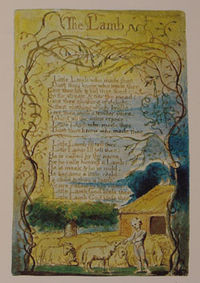
The Lamb
Encyclopedia
"The Lamb" is a poem by William Blake
, published in Songs of Innocence in 1789. Like many of Blake's works, the poem is about Christianity
.
 Like the other Songs of Innocence and Experience, The Lamb was intended to be sung; William Blake's original melody is now lost. It was made into a song by Vaughan Williams
Like the other Songs of Innocence and Experience, The Lamb was intended to be sung; William Blake's original melody is now lost. It was made into a song by Vaughan Williams
. It was also set to music by Sir John Tavener
, who explained, "The Lamb came to me fully grown and was written in an afternoon and dedicated to my nephew Simon for his 3rd birthday." American poet Allen Ginsberg set the poem to music, along with several other of Blake's poems.
The Lamb can be compared to a more grandiose Blake poem: The Tyger
in Songs of Experience.
Critical analysis suggests that both poems, "The Lamb" and "The Tyger," question the Christian belief that God is good; if God is responsible for creating both the good things in life (the lamb) and the evil things (the tyger), how can God be good and moral (cf. theodicee
)?
The lamb is a common metaphor for Jesus Christ, who is also called the "The Lamb of God" in John 1:29.
The layout is set up by two stanzas with the refrain: "Little Lamb who made thee?/Dost thou know who made thee?"
In the first stanza, the speaker wonders who the lamb's creator is; the answer lies at the end of the poem. Here we find a physical description of the lamb, seen as a pure and gentle creature.
In the second stanza, the lamb is compared with the infant Jesus, as well as between the lamb and the speaker's soul. In the last two lines the speaker identifies the creator: God.
William Blake
William Blake was an English poet, painter, and printmaker. Largely unrecognised during his lifetime, Blake is now considered a seminal figure in the history of both the poetry and visual arts of the Romantic Age...
, published in Songs of Innocence in 1789. Like many of Blake's works, the poem is about Christianity
Christianity
Christianity is a monotheistic religion based on the life and teachings of Jesus as presented in canonical gospels and other New Testament writings...
.
Background

Ralph Vaughan Williams
Ralph Vaughan Williams OM was an English composer of symphonies, chamber music, opera, choral music, and film scores. He was also a collector of English folk music and song: this activity both influenced his editorial approach to the English Hymnal, beginning in 1904, in which he included many...
. It was also set to music by Sir John Tavener
John Tavener
Sir John Tavener is a British composer, best known for such religious, minimal works as "The Whale", and "Funeral Ikos"...
, who explained, "The Lamb came to me fully grown and was written in an afternoon and dedicated to my nephew Simon for his 3rd birthday." American poet Allen Ginsberg set the poem to music, along with several other of Blake's poems.
The Lamb can be compared to a more grandiose Blake poem: The Tyger
The Tyger
"The Tyger" is a poem by the English poet William Blake. It was published as part of his collection Songs of Experience in 1794 . It is one of Blake's best-known and most analyzed poems...
in Songs of Experience.
Critical analysis suggests that both poems, "The Lamb" and "The Tyger," question the Christian belief that God is good; if God is responsible for creating both the good things in life (the lamb) and the evil things (the tyger), how can God be good and moral (cf. theodicee
Théodicée
Essais de Théodicée sur la bonté de Dieu, la liberté de l'homme et l'origine du mal , more simply known as Théodicée, is a book of philosophy by the famed polymath Gottfried Leibniz...
)?
The lamb is a common metaphor for Jesus Christ, who is also called the "The Lamb of God" in John 1:29.
Poetic structure
This poem has a simple rhyme scheme : AA BB CC DD AA AA EF GG FE AAThe layout is set up by two stanzas with the refrain: "Little Lamb who made thee?/Dost thou know who made thee?"
In the first stanza, the speaker wonders who the lamb's creator is; the answer lies at the end of the poem. Here we find a physical description of the lamb, seen as a pure and gentle creature.
In the second stanza, the lamb is compared with the infant Jesus, as well as between the lamb and the speaker's soul. In the last two lines the speaker identifies the creator: God.

